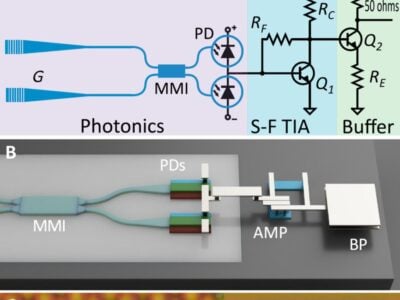Doing away with dyes, researchers shrink pixel colour filters
While pixel size have shrunk considerably over the last decade (from more than 10μm to less than 2μm), designing efficient colour filters that can scale down with the pixel size has remained a challenge. In a paper published in the Nano Letters under the title “Visible Wavelength Color Filters Using Dielectric Subwavelength Gratings for Backside-Illuminated CMOS Image Sensor Technologies”, the researchers highlight the limits of dye-doped polymers often used for RGB colour filters in digital colour imaging and discard plasmonic colour filters for their relatively low absolute efficiency (in the 40 to 50% range), to replace them with seemingly simple dielectric subwavelength gratings.

in the Bayer pattern. The scale bar is 500nm.
The researchers created several colour filter designs (an RGB Bayer pattern on top of a silicon photodiode) at various pixel sizes ranging from 5μm to 1μm. Made of polycrystalline silicon (poly-Si) on top of a SiO2 spacer right over the Si photodiode layer, the micro gratings were demonstrated to exhibit a highly efficient transmission while being nearly insensitive to the light angular incidence.
Experimenting with different hole patterns, they realized an optimum RGB colour filter structure consisting of an 80nm-thick poly-Si slab with air holes, placed on a 115nm thick SiO2 spacer layer sitting on backside-illumination (BSI) Si photodiodes. The red part was consisted of 90nm-diameter holes in a hexagonal lattice with a 250nm periode, the green was designed with a period of 180nm with 140nm-diameter holes in a square lattice, and the blue design had 240nm-diameter holes in a hexagonal lattice with a period of 270nm.
The paper explains that compared to dye-based filters, the dielectric-based filters offer better reliability under ultraviolet illumination and at high temperature. Also, “because of the rotational symmetry of the structures, the spectral response is polarization-insensitive for normal incidence and the filters exhibit relatively insensitive angular responses for each colour which is crucial for maintaining the transmitted colour when shrinking the pixel size” the researchers write.
What’s more, the dielectric grating colour-filters can easily be customized and are compatible with micrometre and sub-micrometre pixel sizes. To make the filter fabrication more compatible with the CMOS backend processes, a pulsed laser low-temperature annealing process could be used to prepare the low-loss poly-Si layers instead of the high temperature annealing the researchers used in their experiments.
“Furthermore, by exploiting the freedom of designing spatially varying phase, amplitude, and polarization of the transmission that subwavelength gratings are capable of, not only the conventional dye-doped colour filters but also the microlenses on top of CIS pixels could be replaced in one layer of dielectric subwavelength grating on top of Si photodiodes layers” they conclude.
Whether Samsung will be licensing the IP or will keep it in its portfolio to commercialize its own sensor solutions, the future will tell.
 If you enjoyed this article, you will like the following ones: don't miss them by subscribing to :
eeNews on Google News
If you enjoyed this article, you will like the following ones: don't miss them by subscribing to :
eeNews on Google News



